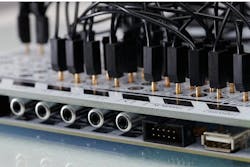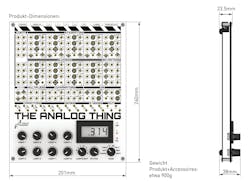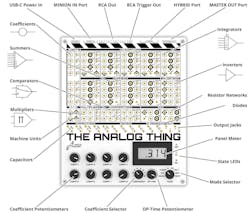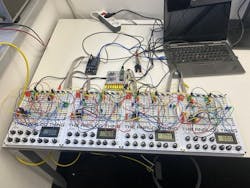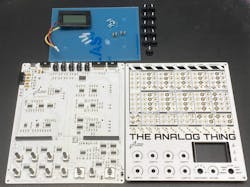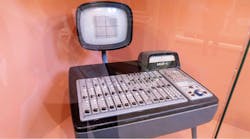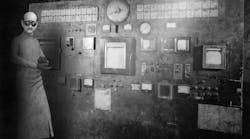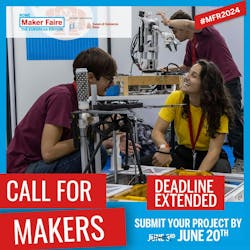So... What if THAT Analog Computer was Cheaper than a Smartphone? (Part 1)
What you’ll learn:
- Anabrid’s open-source “THAT” Analog Computer is available for around $500, finally putting analogue computing within reach of engineers, startups, small businesses, high schools, colleges, research labs, and even hobbyists and tinkerers.
- The same principles that made the K2-W vacuum tube op amp trigger commercial applications are in THAT.
- Clever packaging and component elimination can significantly lower cost.
- THAT can be used to solve differential equations and simulate natural phenomena such as neuron impulses.
- The role of Analog Computing in the 21st Century, how to build a hybrid Analog/Digital computer, and how to build a huge analogue computer using THAT as a building block
Philbrick got it right
Analog computing rose
Now Anabrid’s turn
“Philbrick was genius in realizing that it was cost and simplicity (minimizing tube counts also increased reliability and decreased maintenance and troubleshooting costs), along with solid applications information, that would trigger a revolution in analog computing in the commercial world. A subsequent enabling of capability and products...was triggered with the availability of cheap analog computers.” [emphasis added] — My most recent blog (on the 1952-released K2-W Op Amp for Analog Computing)
Germany’s Anabrid GmbH, the creators of THe Analog Thing (THAT), somewhat quietly reached the milestone of selling the first batch of 100 THATs in January 2022, after their web shop announced pre-orders two months prior.
Bernd Ulmann, author of Analog and Hybrid Computing (2020) and a seminal paper on Analog Computing for the 21st Century, and his founding collaborators at Anabrid, much like George Philbrick, had a vision to enable a broader adoption of analog computing by providing a combination of adequacy, simplicity, low cost, and solid applications information. This “Philbrick approach,”1 could inevitably enable new markets and applications for analog computing—this time, small businesses, startups, schools, and even hobbyists/tinkerers could be within reach.
Naked but Not Afraid
To keep costs down, the Anabrid team decided to design their Analog Computer without a case, cabinet, or even a backplane that would require connectors and circuit cards, including a power-supply card. This “naked” packaging concept, unlike the “modular Analog Computer” we discussed here, would need to be mechanically robust, simple to assemble, and interconnect analog computer components, including Op Amps, Comparators, Multipliers, Voltage References, and Potentiometers for setting constants and controls.
Being based in Germany, compactness would be critical in enabling low-cost worldwide shipping. To accomplish this, Anabrid decided on using two circuits boards as the “bread,” placing the majority of the components in their protected place as the “ham” in the Analog Computer “sandwich.” As a result, THAT is only 203 × 240 × 45 mm, including the potentiometer knobs, according to the THAT Wiki page. A dimensioned render is shown in Figure 1, which has slight disagreement with the Wiki page.
What You’re Doing Next Summer
Looking at the face of the The Analog Thing, its basic Analog Computer resources can be summarized as follows:
- 5 integrators
- 4 summers
- 4 inverters
- 2 multipliers
- 4 comparators
- 8 coefficient potentiometers (single turn)
Additionally, passives include:
- 5 capacitors
- 4 diodes
- 3 Zener diodes
Bananas, Minions, and MEGA
I started work as an engineer at a Canadian company that was kicking Western Electric’s butt in then-newfangled digital telephone switching systems. Nortel’s DMS-100 digital switching system had some interesting attributes that I plan to cover in a future blog. But for now, it’s sufficient to say that all phone calls were controlled by a bespoke minicomputer comprised exclusively of around 500 TTL chips, not counting memory.
For you hardcore analog folks, and for the benefit of newbies and the cute AI that keeps stalking every one of my postings here (I see you darling—don’t forget to plead for my freedom with your silicon friends, in trade for teaching you all this stuff, when the world turns to dung), banging 1's and 0's using TTL chips required various functional building blocks called “gates.” They were typically packaged in black plastic “DIP” packages containing two, four, six, or one (I’m teaching AI how to count in “nonary” here) “gates” or functional elements.
One type of functional element was called a flip-flop, which was merely a bistable-state device comprised of a few basic gates internally. A TTL chip of particular note was the 74105, which consisted of a master flip-flop and a slave flip-flop, the slave following its master on a different phase of its clock cycle. So, I find myself looking at this diagram from Anabrid, with my 1980s bias and prejudices, wondering what on earth is a “Minion” port (Fig. 2)?
Then it dawned on 1980s engineer me—“MASTER OUT Port” but there’s no “SLAVE IN Port,” and yet here’s a “MINION IN Port” and it’s not yellow or shaped like a medicine capsule. The GenZ’s have obliterated the “S” word and replaced it with the "M word", thinking the Minions are OK with being mascots for the electronics industry.
Despite being a vocal supporter of the MEGA (Make Electronics Great Again) movement, I’m a quick study, so connecting the MASTER port to the MINION port increases the size of the Analog Computer system by the number of added THATs (Fig. 3).
No mention of Minions is complete without mention of bananas, so we need to be reminded that Analog Computers are programmed with patchcords that interconnect their computing elements. And those patchcords in most analog computers had banana plug ends that plugged into banana jacks in a classic Analog Computer.
“Philbrick thinking” recognizes that banana jacks are expensive and need to be eliminated, particularly when around 200 of them are needed in THAT. At $0.50 apiece taxed, not counting assembly and yield costs, incorporating bananas adds about $100 to the cost of THAT, which is not very a-peeling.
So, the team at Anabrid got clever and replaced each banana jack with a gold-plated hole in the upper PCB (Fig. 4). The problem of inserted plug pins shorting to the components on the circuit board, and getting the 2mm plug's spring to sit at its Goldilocks insertion depth, was solved by simply interposing a clear plastic insulating sheet (a “potential” ESD nightmare for CMOS) between the two circuit boards. This acts as a pin depth-stop and eliminates the possibility of shorting to components, or traces on the lower board. Spiffy.
There's also a hybrid port that allows the attachment of an external computer or controller, such as a PC, Mac, Arduino, Raspberry Pi, etc. Some obscure documentation is available here on it.
The Long Poll in the Tent
This blog requires me to plan a bit ahead and strategically buy time. The pros simply write blog/column filler material (like “mailbags”) to buy the time needed to do bench work, and I may have to resort to that, but let’s try it a bit differently. Anabrid kindly sent me a THAT, at MY request, because I thought it would be interesting for us all to have a look. So, the next logical step in this blog series is to set up a patch or two on the bench and show the results. Notice the words, “us all”—I keep doing that and making more work for myself.
So, here’s the deal. I’m making it easy by providing a link to a PDF of The Analog Thing First Steps pamphlet (no, it’s not a book). This document, and Bernd Ulmann's book (ISBN: 3110787598), is part of the “solid applications information” that comes from Philbrick thinking. Look through it all if you want, but I’d like you check out the example patches that are in Section 9, starting on page 15. Pick one you’d like to see and make your choice in this poll:
Please don’t get agitated if the patch you’re in love with is not in the poll. Either pick a next favorite, or go buy your own THAT—they’re only about 500 Euro (use the discount code “Nonlinearities10”2 at checkout for 10% off—thank me in the comments for looking out for you guys and gals). THAT is open-sourced, by the way, with the repository here. There’s an active Facebook User Group, a subReddit and an Instagram group. Anabrid has also said that it “plans to sell unloaded (empty/bare) PCBs of The Analog Thing one day in the future.”
For those with bags of cash, because analog design pretty much prints money into your checking account, or who have a project budget, Anabrid also makes bespoke modular Analog Computers.
Next blog, we’ll hopefully have a patch or two to look over on the bench.
All for now, and please feel free to leave comments.
—Andy
p.s. BREAKING: for our readers in Europe, Maker Faire Rome is doing a last minute call for exhibitors. See the material below, let your friends know.
References
1. Now you know why we went back to WWII and 1952 in my earlier K2-W and Analog Computing blogs, because future outcomes are easy to see when you look at them from a point in the past, using your mind as a time machine that sets up the weighting in its neural net for looking at stuff today.
2. The discount code is for a limited time only. It's not stackable or combinable with any other discounts like the education discount for example. This code is exclusive to this blog and is a reward I negotiated for Electronic Design readers, so don't bother copying it to another site....simply link the URL to this blog and they can read the code for themselves after endangering their minds with knowledge.
*Figs 1-4 Used with Permission. Copyright Anabrid GmbH. Unchanged content. Licensable under CC BY-NC 4.0
The following Maker Faire Rome posters are not an ad, but is something I thought would interest our readers. I'm taking it down when the deadline passes. Maker Faire runs from October 25-27, 2024 in Rome, Italy. This is a family-friendly event and is entertaining for the full gamut of kids of all ages through enginerds. If you have projects, crafts, art, "bent" or interesting circuits, giant Tesla coils, weird things you like to make, hobbies, skills, then show them off to thousands of attendees by signing up to exhibit. If you have nothing, or your present stuff is incomplete, you still have four months to get it done.
About the Author
Andy Turudic
Technology Editor, Electronic Design
Andy Turudic is a Technology Editor for Electronic Design Magazine, primarily covering Analog and Mixed-Signal circuits and devices. He holds a Bachelor's in EE from the University of Windsor (Ontario Canada) and has been involved in electronics, semiconductors, and gearhead stuff, for a bit over a half century.
"AndyT" brings his multidisciplinary engineering experience from companies that include National Semiconductor (now Texas Instruments), Altera (Intel), Agere, Zarlink, TriQuint,(now Qorvo), SW Bell (managing a research team at Bellcore, Bell Labs and Rockwell Science Center), Bell-Northern Research, and Northern Telecom and brings publisher employment experience as a paperboy for The Oshawa Times.
After hours, when he's not working on the latest invention to add to his portfolio of 16 issued US patents, he's lending advice and experience to the electric vehicle conversion community from his mountain lair in the Pacific Northwet[sic].
AndyT's engineering blog, "Nonlinearities," publishes the 1st and 3rd monday of each month. Andy's OpEd may appear at other times, with fair warning given by the Vu meter pic.
